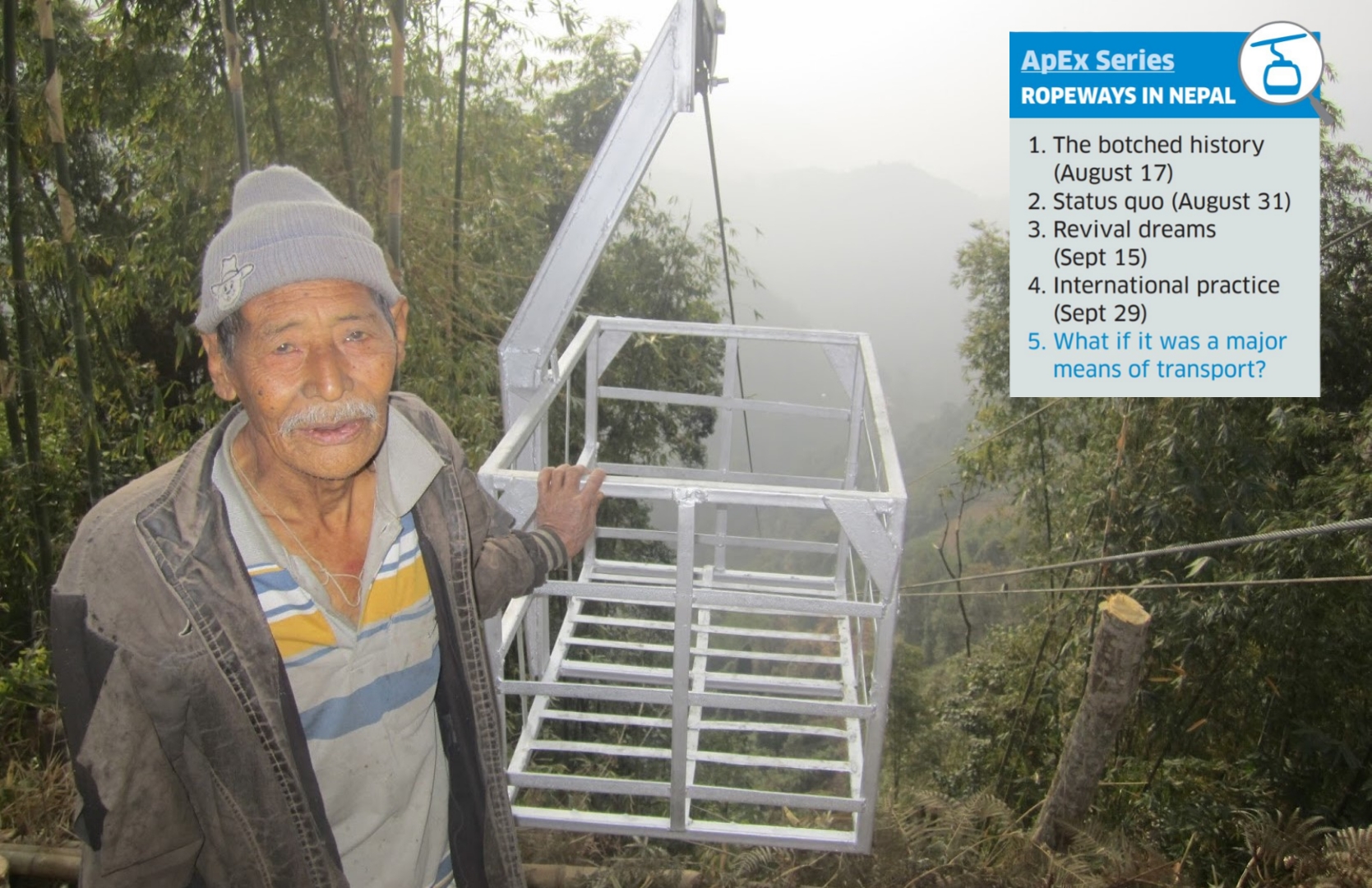Ropeways are an ideal means of human and goods transport in Nepal, a country filled with rugged mountains and hills. In fact, installing ropeways is six times cheaper than building roads. The 42-km Hetauda-Kathmandu Ropeway, for instance, cost half as much as the Tribhuvan Highway on the same route to build. Studies suggest Nepal could have up to 2,000 ropeways and feasibility studies have been completed on 62 of them. But only five ropeways for human transport and almost a dozen gravity goods ropeways are in operation in the country.
The 22-km-long Tri Chandra Nepal Tara Ropeway came into operation in 1927, and it is believed to be one of the first ropeways in the whole of South Asia. But despite being a ropeway pioneer country in the region, Nepal’s infrastructure development has largely revolved around building roads. What if ropeways were the major means of transport in Nepal? We have to see the economic, environmental and social aspects, says Dipak Gyawali, former water resource minister. “Being six times cheaper than building roads, ropeway, for one, would have helped significantly to minimize national expenses.”
But neither the Ministry of Physical Infrastructure and Transport nor the National Planning Commission (NPC) has any plans and policies for ropeways. Chandra Mani Adhikari, economist and former NPC member, says ropeway development is certainly food for thought. “Even with the saving of 10 percent fuel, there will be a national saving of Rs 20bn,” says Adhikari. “This is important, given that Nepal imports almost Rs 200bn worth of fuel a year.” As the major goods carrying ropeways got abandoned post-2000, there is no real data on how they would have performed.
But until they were in operation, they had shown promising results. For instance, the rate fixed by the government for goods transported by the Nepal Tara Ropeway was Rs 346.80 per ton against Rs 480 charged by trucks. Provided there were sufficient goods to transport, ropeway shutdown for even a single day resulted in a revenue loss of Rs 53,407, contends Shyam Sundar Shrestha in the book ‘Ropeways in Nepal’ by Dipak Gyawali, Ajaya Dixit, and Madhukar Upadhya. Another case for the ropeway is that of Himal Hydro Project. It had three ropeways—Andhi Khola, Jhimruk and Khitmi—for transporting goods and raw materials.
The cost of hauling goods by Andhi Khola Ropeway was compared against the road, porter and mule transports by Resham Raj Dhakal, whose outcome has been published in the same book. It states that to gain 250 meters in elevation for every 1,200 meters would have required constructing three kilometers of road, which, at the prevailing prices for hill terrain, would have cost about Rs 30m. A second choice was to hire porters at an expensive cost of about two to three rupees per kilogram. Mules were available at rates up to Rs 1.5 per kilogram.
Considering the depreciation of the ropeway system and its equipment as well as the interest on borrowed capital (20 percent depreciation and 15 percent interest), the annual capital cost of the ropeway was estimated to be about Rs 805,000 (0.35×2.3m). The annual operation and maintenance costs of the ropeway system came to Rs 110,000 a year. In a year, the ropeway transported 1,300 tons of materials at the cost of Rs 704 per ton. This was three times less expensive than what porters would have charged. There are also environmental and social benefits to prioritizing ropeways over roads, particularly in a country like Nepal made largely of hill and mountain terrains.
Landslides and erosion are regular occurrences in the hill and mountain districts of Nepal. These events have been exacerbated by unplanned development projects, where large swathes of forest covers are denuded. During this Dashain festival alone, over 20 people died and properties worth millions were damaged or destroyed as a result of landslides. Rastriya Samachar Samiti, the state news agency, reported the death of seven members of a family in an incessant rainfall-triggered landslide that buried their house at Barkotebada, Kanaksundari Rural Municipality-5, Jumla, on October 8.The rainfall also blocked and damaged roads in many places in the highland district.
Government data suggest that, on an average, 2,500 people are killed in road accidents every year while thousands of others are injured. Globally, Nepal is among the countries with highest death rates caused by road accidents. These road accidents not only affect the families, but they also have a bad impact on the national economy. “If we had adopted ropeways, these disasters and fatalities would have been minimized,” says Gyawali. Besides causing disasters and fatalities, unplanned development projects are also damaging our environment in general, says Bhushan Tuladhar, clean energy campaigner. “Our constitution mentions a clean environment as a fundamental right of citizens. Yet, international studies show that every year approximately 42,000 Nepalis die from air pollution,” says Tuladhar. “So yes, ropeways would have been a good idea.”











